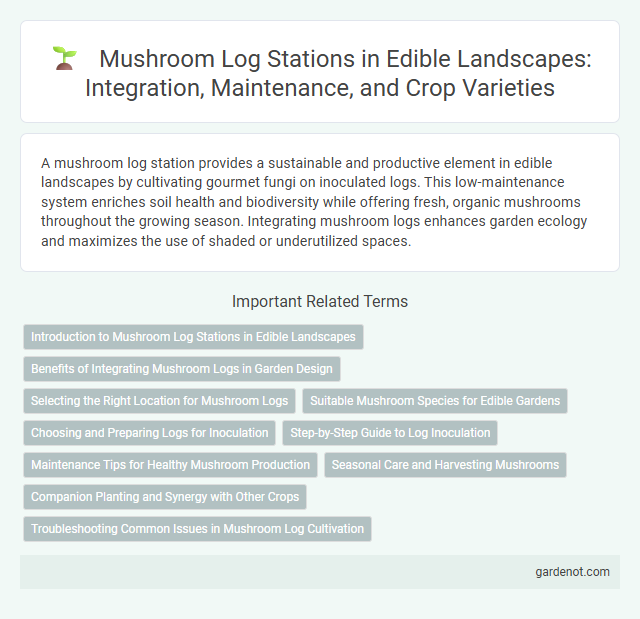A mushroom log station provides a sustainable and productive element in edible landscapes by cultivating gourmet fungi on inoculated logs. This low-maintenance system enriches soil health and biodiversity while offering fresh, organic mushrooms throughout the growing season. Integrating mushroom logs enhances garden ecology and maximizes the use of shaded or underutilized spaces.
Introduction to Mushroom Log Stations in Edible Landscapes
Mushroom log stations serve as innovative edible landscape features by cultivating gourmet fungi such as shiitake and oyster mushrooms on hardwood logs. These stations promote sustainable food production, enhance biodiversity, and offer a renewable source of fresh mushrooms directly within garden settings. Utilizing inoculated logs, growers can consistently harvest nutrient-rich mushrooms, integrating ecological function with culinary value.
Benefits of Integrating Mushroom Logs in Garden Design
Integrating mushroom logs into garden design enhances biodiversity by providing a natural habitat for fungi, which contribute to soil health through decomposition and nutrient cycling. These logs support sustainable gardening by reducing waste and promoting organic growth without synthetic inputs. Incorporating mushroom logs also increases food security by producing fresh, nutrient-rich mushrooms directly within the edible landscape.
Selecting the Right Location for Mushroom Logs
Choosing the ideal location for mushroom logs involves selecting a shaded, humid area with good air circulation to prevent mold and ensure optimal growth. The site should be protected from direct sunlight and strong winds, maintaining consistent moisture levels through natural shade or nearby plants. Proximity to water sources enhances ease of watering and sustaining the mushroom cultivation environment.
Suitable Mushroom Species for Edible Gardens
Oyster mushrooms (Pleurotus ostreatus) and shiitake mushrooms (Lentinula edodes) are ideal for edible garden mushroom log stations due to their adaptability and high yield on hardwood logs. These species thrive in shaded, moist environments and decompose common tree species like oak, maple, and poplar, providing a sustainable food source and contributing to soil health. Incorporating mushroom logs into edible landscapes enhances biodiversity and offers a continuous harvest of nutritious fungi.
Choosing and Preparing Logs for Inoculation
Select hardwood logs such as oak, beech, or maple, ideally cut within two weeks to ensure optimal moisture content for mushroom inoculation. Prepare logs by trimming branches and drilling evenly spaced holes to insert mushroom spawn plugs or sawdust, promoting efficient mycelium colonization. Maintain logs in a shaded, humid environment to enhance fungal growth and successful fruiting in the edible landscape.
Step-by-Step Guide to Log Inoculation
Select hardwood logs such as oak or maple, cut them fresh within 2 weeks of inoculation, and drill holes 1 inch deep spaced 4-6 inches apart. Insert mushroom spawn dowels into the holes, then seal with wax to protect against contamination and moisture loss. Store inoculated logs in shaded, humid environments for 6-12 months until fruiting bodies begin to emerge.
Maintenance Tips for Healthy Mushroom Production
Regularly monitor moisture levels in the mushroom log station, ensuring the logs remain consistently damp without becoming waterlogged to promote optimal fungal growth. Maintain a shaded environment with good air circulation to prevent overheating and contamination from competing molds. Periodic inspection for pests and prompt removal of decayed or contaminated logs helps sustain a healthy, productive edible landscape.
Seasonal Care and Harvesting Mushrooms
Mushroom log stations require consistent moisture and shade management during seasonal changes to promote optimal fungal growth. Regularly monitoring humidity and temperature ensures the logs remain healthy and productive throughout the year. Harvesting mushrooms at their peak maturity enhances flavor and maximizes yield without damaging the mycelium for future growth cycles.
Companion Planting and Synergy with Other Crops
Mushroom log stations enhance edible landscapes by promoting companion planting and crop synergy, as mushrooms break down organic matter, enriching the soil with nutrients beneficial to nearby plants. Integrating mushroom logs with crops like nitrogen-fixing legumes or shade-loving greens creates a mutually supportive environment, improving plant health and yield. This symbiotic approach maximizes space efficiency and sustains soil fertility while fostering biodiversity in garden ecosystems.
Troubleshooting Common Issues in Mushroom Log Cultivation
Mushroom log cultivation often encounters issues such as contamination, slow mycelium growth, and improper moisture levels. Contamination can be minimized by sterilizing logs and using high-quality spawn, while maintaining consistent humidity between 80-90% promotes healthy mycelium development. Addressing these challenges promptly enhances yield and ensures a sustainable edible landscape.
Mushroom log station Infographic

 gardenot.com
gardenot.com